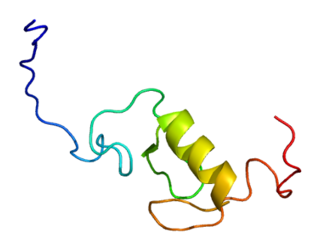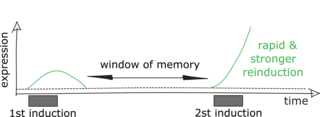Related Research Articles

In biology, histones are highly basic proteins abundant in lysine and arginine residues that are found in eukaryotic cell nuclei and in most Archaeal phyla. They act as spools around which DNA winds to create structural units called nucleosomes. Nucleosomes in turn are wrapped into 30-nanometer fibers that form tightly packed chromatin. Histones prevent DNA from becoming tangled and protect it from DNA damage. In addition, histones play important roles in gene regulation and DNA replication. Without histones, unwound DNA in chromosomes would be very long. For example, each human cell has about 1.8 meters of DNA if completely stretched out; however, when wound about histones, this length is reduced to about 9 micrometers (0.09 mm) of 30 nm diameter chromatin fibers.

Paired amphipathic helix protein Sin3a is a protein that in humans is encoded by the SIN3A gene.

Histone deacetylase 4, also known as HDAC4, is a protein that in humans is encoded by the HDAC4 gene.

Histone-lysine N-methyltransferase 2A, also known as acute lymphoblastic leukemia 1 (ALL-1), myeloid/lymphoid or mixed-lineage leukemia1 (MLL1), or zinc finger protein HRX (HRX), is an enzyme that in humans is encoded by the KMT2A gene.

Lysine-specific demethylase 5A is an enzyme that in humans is encoded by the KDM5A gene.

Paired amphipathic helix protein Sin3b is a protein that in humans is encoded by the SIN3B gene.

WD repeat-containing protein 5 is a protein that in humans is encoded by the WDR5 gene.

E3 ubiquitin-protein ligase BRE1A is an enzyme that in humans is encoded by the RNF20 gene.

Lysine-specific demethylase 5C is an enzyme that in humans is encoded by the KDM5C gene. KDM5C belongs to the alpha-ketoglutarate-dependent hydroxylase superfamily.

Histone-lysine N-methyltransferase 2D (KMT2D), also known as MLL4 and sometimes MLL2 in humans and Mll4 in mice, is a major mammalian histone H3 lysine 4 (H3K4) mono-methyltransferase. It is part of a family of six Set1-like H3K4 methyltransferases that also contains KMT2A, KMT2B, KMT2C, KMT2F, and KMT2G.

Set1/Ash2 histone methyltransferase complex subunit ASH2 is an enzyme that in humans is encoded by the ASH2L gene.

Protein ENL is a protein that in humans is encoded by the MLLT1 gene.

Polycomb group RING finger protein 6 is a protein that in humans is encoded by the PCGF6 gene.

Protein IWS1 homolog also known as interacts with Spt6 (IWS1) is a protein that in humans is encoded by the IWS1 gene.

ASH1L is a histone-lysine N-methyltransferase enzyme encoded by the ASH1L gene located at chromosomal band 1q22. ASH1L is the human homolog of Drosophila Ash1.
Trithorax-group proteins (TrxG) are a heterogeneous collection of proteins whose main action is to maintain gene expression. They can be categorized into three general classes based on molecular function:
- histone-modifying TrxG proteins
- chromatin-remodeling TrxG proteins
- DNA-binding TrxG proteins,

Ali Shilatifard is an American biochemist, molecular biologist, the Robert Francis Furchgott Professor and chairman of the department of biochemistry and molecular genetics, and the director of the Simpson Query Institute for Epigenetics at the Northwestern University Feinberg School of Medicine. He has served as a member of the Senior Editorial Board for the journal Science. He also served as the founding Deputy Editor and the first academic Editor for Science's open access journal Science Advances between 2014 and 2023. During his tenure as the editor of Science Advances, the journal brought onboard roughly 50 deputy editors and over 350 associate editors managing over 22,000 annual submissions and roughly 2,000 annual publications, reaching an impact factor of 14.98. He has served on the Scientific Advisory Board (SAB) of Keystone Symposia, Max Planck Society, and Genentech and is a member of the jury for the BBVA Foundation Prize in Medicine.

Transcriptional memory is a biological phenomenon, initially discovered in yeast, during which cells primed with a particular cue show increased rates of gene expression after re-stimulation at a later time. This event was shown to take place: in yeast during growth in galactose and inositol starvation; plants during environmental stress; in mammalian cells during LPS and interferon induction. Prior work has shown that certain characteristics of chromatin may contribute to the poised transcriptional state allowing faster re-induction. These include: activity of specific transcription factors, retention of RNA polymerase II at the promoters of poised genes, activity of chromatin remodeling complexes, propagation of H3K4me2 and H3K36me3 histone modifications, occupancy of the H3.3 histone variant, as well as binding of nuclear pore components. Moreover, locally bound cohesin was shown to inhibit establishment of transcriptional memory in human cells during interferon gamma stimulation.
H3K4me1 is an epigenetic modification to the DNA packaging protein Histone H3. It is a mark that indicates the mono-methylation at the 4th lysine residue of the histone H3 protein and often associated with gene enhancers.
Set1 is a gene that codes for Histone-lysine N-methyltransferase and H3 lysine-4 specific proteins (H3K). Set1 proteins can also be referred to as COMPASS proteins. The first H3K4 methylase, Saccharomyces cerevisiae Set1/COMPASS, is highly conserved across a multitude of phylogenies. The histone methylation facilitated by Set1 is required for cell growth and transcription silencing through the repression of RNA polymerase II. The Set1C, COMPASS Complex, also aids in transcription elongation regulation and the maintenance of telomere length.
References
- 1 2 3 Shilatifard, Ali (December 10, 2012). "The COMPASS Family of Histone H3K4 Methylases: Mechanisms of Regulation in Development and Disease Pathogenesis". Annual Review of Biochemistry. 81 (1): 65–95. doi:10.1146/annurev-biochem-051710-134100. PMC 4010150 . PMID 22663077.
- ↑ Miller, Trissa; Krogan, Nevan J.; Dover, Jim; Erdjument-Bromage, H.; Tempst, Paul; Johnston, Mark; Greenblatt, Jack F.; Shilatifard, Ali (November 6, 2001). "COMPASS: A complex of proteins associated with a trithorax-related SET domain protein". Proceedings of the National Academy of Sciences. 98 (23): 12902–12907. Bibcode:2001PNAS...9812902M. doi: 10.1073/pnas.231473398 . PMC 60797 . PMID 11687631.
- 1 2 3 Takahashi, Yoh-hei; Westfield, Gerwin H.; Oleskie, Austin N.; Trievel, Raymond C.; Shilatifard, Ali; Skiniotis, Georgios (2011-12-20). "Structural analysis of the core COMPASS family of histone H3K4 methylases from yeast to human". Proceedings of the National Academy of Sciences. 108 (51): 20526–20531. Bibcode:2011PNAS..10820526T. doi: 10.1073/pnas.1109360108 . ISSN 0027-8424. PMC 3251153 . PMID 22158900.
- ↑ Qu, Qianhui; Takahashi, Yoh-hei; Yang, Yidai; Hu, Hongli; Zhang, Yan; Brunzelle, Joseph S.; Couture, Jean-Francois; Shilatifard, Ali; Skiniotis, Georgios (2018-08-23). "Structure and Conformational Dynamics of a COMPASS Histone H3K4 Methyltransferase Complex". Cell. 174 (5): 1117–1126.e12. doi:10.1016/j.cell.2018.07.020. ISSN 0092-8674. PMC 6108936 . PMID 30100186.